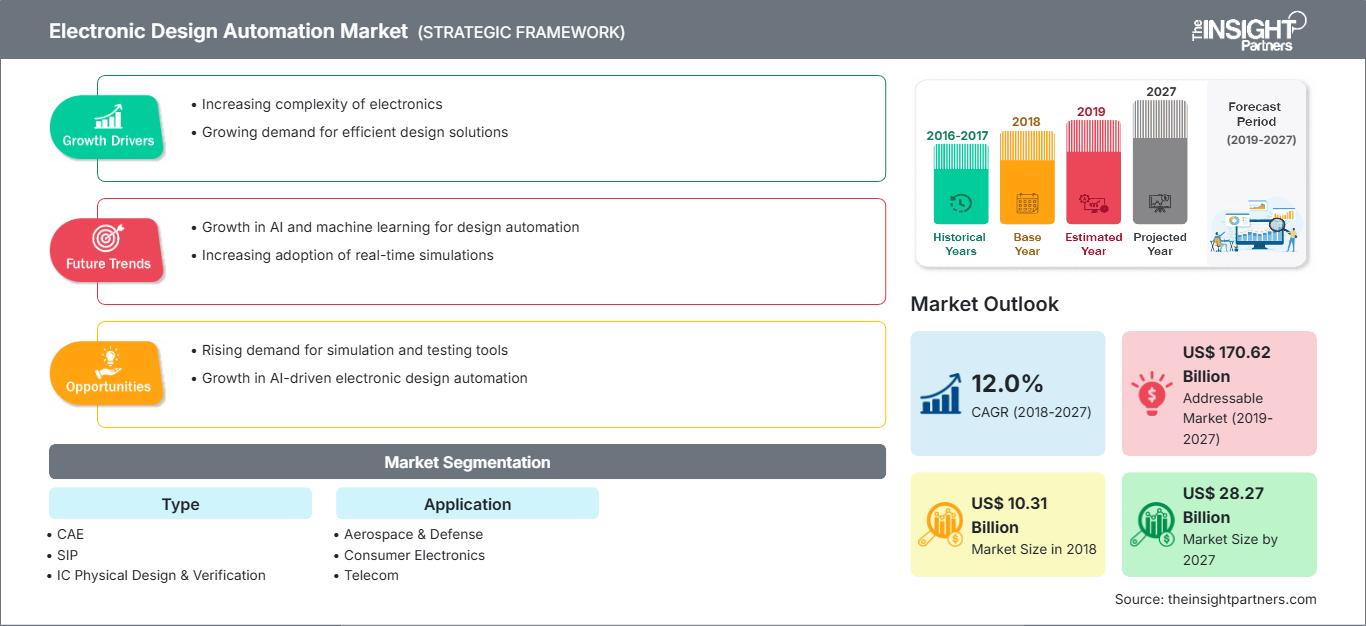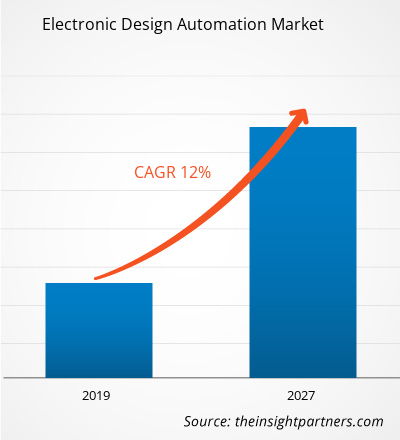Der Markt für elektronische Designautomatisierung belief sich 2018 auf 10,31 Milliarden US-Dollar und soll im Prognosezeitraum 2019–2027 mit einer durchschnittlichen jährlichen Wachstumsrate von 12,0 % wachsen und bis 2027 28,27 Milliarden US-Dollar erreichen.
Software für elektronische Designautomatisierung umfasst mehrere Tools und Anwendungen. Die Integration dieser Tools entsprechend der Kundennachfrage kann sich manchmal als komplizierte Aufgabe erweisen. Die komplexen Anforderungen der Endbenutzer hinsichtlich einer hochstabilen und genauen Produktpositionierung werden mit Hilfe von EDA erfüllt. Die zunehmende Komplexität und die Kostenherausforderungen, mit denen die Industrie bei der Implementierung teurer, komplexer Designs konfrontiert ist, sind die Hauptfaktoren, die die Nachfrage nach EDA antreiben.Der asiatisch-pazifische Raum wird voraussichtlich die dominierende Region im Markt für elektronische Designautomatisierung sein. Der Hauptgrund dafür ist das riesige Elektronik- und Halbleiterzentrum in China in Verbindung mit der hohen Bevölkerungsdichte der Region. Darüber hinaus ist China für die weltweit größten Halbleiterlieferungen verantwortlich. Es wird erwartet, dass die neuen Marktinitiativen und strategischen Partnerschaften im Prognosezeitraum fortgesetzt werden und zu einem starken Wachstum des Marktes für elektronische Designautomatisierung in der Region beitragen.
Passen Sie diesen Bericht Ihren Anforderungen an
Sie erhalten kostenlos Anpassungen an jedem Bericht, einschließlich Teilen dieses Berichts oder einer Analyse auf Länderebene, eines Excel-Datenpakets sowie tolle Angebote und Rabatte für Start-ups und Universitäten.
Markt für elektronische Designautomatisierung: Strategische Einblicke

- Holen Sie sich die wichtigsten Markttrends aus diesem Bericht.Dieses KOSTENLOSE Beispiel umfasst Datenanalysen, die von Markttrends bis hin zu Schätzungen und Prognosen reichen.
Wachstum der Halbleiterindustrie
Sie erhalten kostenlos Anpassungen an jedem Bericht, einschließlich Teilen dieses Berichts oder einer Analyse auf Länderebene, eines Excel-Datenpakets sowie tolle Angebote und Rabatte für Start-ups und Universitäten.
Markt für elektronische Designautomatisierung: Strategische Einblicke

- Holen Sie sich die wichtigsten Markttrends aus diesem Bericht.Dieses KOSTENLOSE Beispiel umfasst Datenanalysen, die von Markttrends bis hin zu Schätzungen und Prognosen reichen.
Die SIA (Semiconductor Industry Association), die die führende US-amerikanische Branche in der Halbleiterforschung, -entwicklung und -fertigung vertritt, verzeichnete im Oktober 2018 einen Anstieg von 12,7 % gegenüber 2017 und einen Gesamtumsatz von 41,8 Milliarden US-Dollar. Darüber hinaus prognostizierte die WSTS eine Steigerung von 15,9 % für 2018 und 2,6 % für 2019. Dieses Wachstum der Halbleiterindustrie hat das Vertrauen der Akteure im Markt für elektronische Designautomatisierung in Bezug auf das Umsatzwachstum gestärkt. Die in der Halbleiterbranche tätigen Unternehmen erwarten nicht nur einen deutlichen Umsatzanstieg, sondern erhöhen auch entsprechend ihre Ausgaben für Forschung und Entwicklung. Die jährlichen Steigerungen der Ausgaben für Forschung und Entwicklung haben dem Markt für elektronische Designautomatisierung in der jüngeren Vergangenheit einen bemerkenswerten Schub verliehen und werden den Markt Prognosen zufolge auch in den kommenden Jahren antreiben.
Da sich die Halbleiterindustrie weiterhin in einem starken Aufschwung befindet, wird von den führenden Unternehmen im Markt für elektronische Designautomatisierung erwartet, dass sie einen zukunftsorientierten Ansatz verfolgen und unkonventionelle Endmärkte wie künstliche Intelligenz, autonome Fahrzeuge und IoT in Betracht ziehen. Darüber hinaus werden die Speicherhersteller voraussichtlich steigende Umsätze aufgrund der steigenden Nachfrage nach Rechenzentrums-, Smartphone- und autonomen Fahrzeugtechnologien verzeichnen. Die Konvergenz unzähliger Halbleiter-Endverbrauchermärkte hat zu einer erheblichen Expansion der Branche geführt, die wiederum den Markt für elektronische Designautomatisierung für Technologie, Software und Automatisierung vorangetrieben hat.
Steigende Durchdringung von IoT, künstlicher Intelligenz und virtueller Realität
Smart Homes, Fernseher, Smartphones, Internet der Dinge, vernetzte Autos und künstliche Intelligenz – die Unterhaltungselektronikbranche hat jeden Aspekt des menschlichen Lebens durchdrungen. Die weltweite Nachfrage nach Unterhaltungselektronik wird weitgehend durch den Wunsch der Verbraucher nach größeren, neueren und verbesserten Funktionen getrieben, was den Sektor wiederum dazu ermutigt hat, ständig nach Innovationen und Technologien zu forschen, die nicht nur die Vorstellungskraft der Menschen beflügeln, sondern auch erschwinglich und im Hinblick auf die Befriedigung ihrer täglichen Bedürfnisse relevant sind. In solchen Fällen unterstützen die EDA-Softwareanbieter die Hersteller elektronischer Komponenten und Technologen beim Entwurf geeigneter Geräteprototypen. Daher wird erwartet, dass die sich wandelnden Erwartungen der Verbraucher und die wachsende Nachfrage nach Unterhaltungselektronik den EDA-Markt in den kommenden Jahren antreiben werden.
Nachfolgend sind einige der jüngsten Strategien einiger Akteure im Markt für elektronische Designautomatisierung aufgeführt:
2018: Cadence Design Systems, Inc. kündigte eine strategische Partnerschaft mit Green Hills Software an, um die Sicherheit eingebetteter Geräte zu beschleunigen. Cadence Design Systems, Inc. investierte 150 Millionen US-Dollar, was etwa 16 % der Anteile an GreenHill entspricht. 2018: Keysight Technologies wurde von ON Semiconductor als EDA-Partner für die Entwicklung einer Designlösung für Leistungsbauelemente ausgewählt, die die Zuverlässigkeit erhöhen und die Markteinführungszeit verkürzen soll. 2018: Synopsys, Inc. und die Siemens AG gaben eine Zusammenarbeit für eine breite Palette von EDA-Projekten bekannt. Darüber hinaus haben Siemens und Synopsys alle offenen Patentstreitigkeiten zwischen Synopsys und Mentor Graphics beigelegt.
Der Bericht segmentiert den globalen Markt für elektronische Designautomatisierung wie folgt:Electronic Design AutomationRegionale Einblicke in den Markt für Electronic Design Automation
Regionale Einblicke in den Markt für Electronic Design Automation
Die Analysten von The Insight Partners haben die regionalen Trends und Faktoren, die den Markt für Electronic Design Automation im Prognosezeitraum beeinflussen, ausführlich erläutert. In diesem Abschnitt werden auch die Marktsegmente und die geografische Lage in Nordamerika, Europa, dem asiatisch-pazifischen Raum, dem Nahen Osten und Afrika sowie Süd- und Mittelamerika erörtert.
Umfang des Marktberichts zur elektronischen Designautomatisierung
| Berichtsattribut | Einzelheiten |
|---|---|
| Marktgröße in 2018 | US$ 10.31 Billion |
| Marktgröße nach 2027 | US$ 28.27 Billion |
| Globale CAGR (2018 - 2027) | 12.0% |
| Historische Daten | 2016-2017 |
| Prognosezeitraum | 2019-2027 |
| Abgedeckte Segmente |
By Typ
|
| Abgedeckte Regionen und Länder | Nordamerika
|
| Marktführer und wichtige Unternehmensprofile |
|
Dichte der Marktteilnehmer im Bereich Electronic Design Automation: Verständnis ihrer Auswirkungen auf die Geschäftsdynamik
Der Markt für Electronic Design Automation wächst rasant. Die steigende Nachfrage der Endnutzer ist auf Faktoren wie veränderte Verbraucherpräferenzen, technologische Fortschritte und ein stärkeres Bewusstsein für die Produktvorteile zurückzuführen. Mit der steigenden Nachfrage erweitern Unternehmen ihr Angebot, entwickeln Innovationen, um den Bedürfnissen der Verbraucher gerecht zu werden, und nutzen neue Trends, was das Marktwachstum weiter ankurbelt.

- Holen Sie sich die Markt für elektronische Designautomatisierung Übersicht der wichtigsten Akteure
Globaler Markt für elektronische Designautomatisierung – nach Typ
- Computer Aided Engineering (CAE)
- Halbleiter-IP (SIP)
- IC-Physikalisches Design und Verifizierung
- Leiterplatte (PCB) und Multi-Chip-Modul (MCM)
Globaler Markt für elektronische Designautomatisierung – nach Anwendung
- Luft- und Raumfahrt Verteidigung
- Unterhaltungselektronik
- Telekommunikation
- Automobil
- Industrie
- Sonstige
Globaler Markt für Electronic Design Automation – nach Geografie
- Nordamerika
- USA
- Kanada
- Mexiko
- Europa
- Frankreich
- Deutschland
- Italien
- Spanien
- Großbritannien
- Übriges Europa
- Asien-Pazifik (APAC)
- China
- Indien
- Japan
- Südkorea
- Übriger APAC
- Übriger der Welt (RoW)
- Südamerika
- Naher Osten und Afrika
Globaler Markt für elektronische Designautomatisierung – Unternehmensprofile
- Agnisys Inc.
- Aldec, Inc.
- Autodesk, Inc.
- Cadence Design Systems, Inc.
- Labcenter Electronics Ltd.
- Keysight Technologies
- Mentor Graphics Corporation
- Silvaco, Inc.
- Synopsys, Inc.
- Zuken Inc.
- Historische Analyse (2 Jahre), Basisjahr, Prognose (7 Jahre) mit CAGR
- PEST- und SWOT-Analyse
- Marktgröße Wert/Volumen – Global, Regional, Land
- Branchen- und Wettbewerbslandschaft
- Excel-Datensatz
Aktuelle Berichte
Erfahrungsberichte
Grund zum Kauf
- Fundierte Entscheidungsfindung
- Marktdynamik verstehen
- Wettbewerbsanalyse
- Kundeneinblicke
- Marktprognosen
- Risikominimierung
- Strategische Planung
- Investitionsbegründung
- Identifizierung neuer Märkte
- Verbesserung von Marketingstrategien
- Steigerung der Betriebseffizienz
- Anpassung an regulatorische Trends






















 Kostenlose Probe anfordern für - Markt für elektronische Designautomatisierung
Kostenlose Probe anfordern für - Markt für elektronische Designautomatisierung